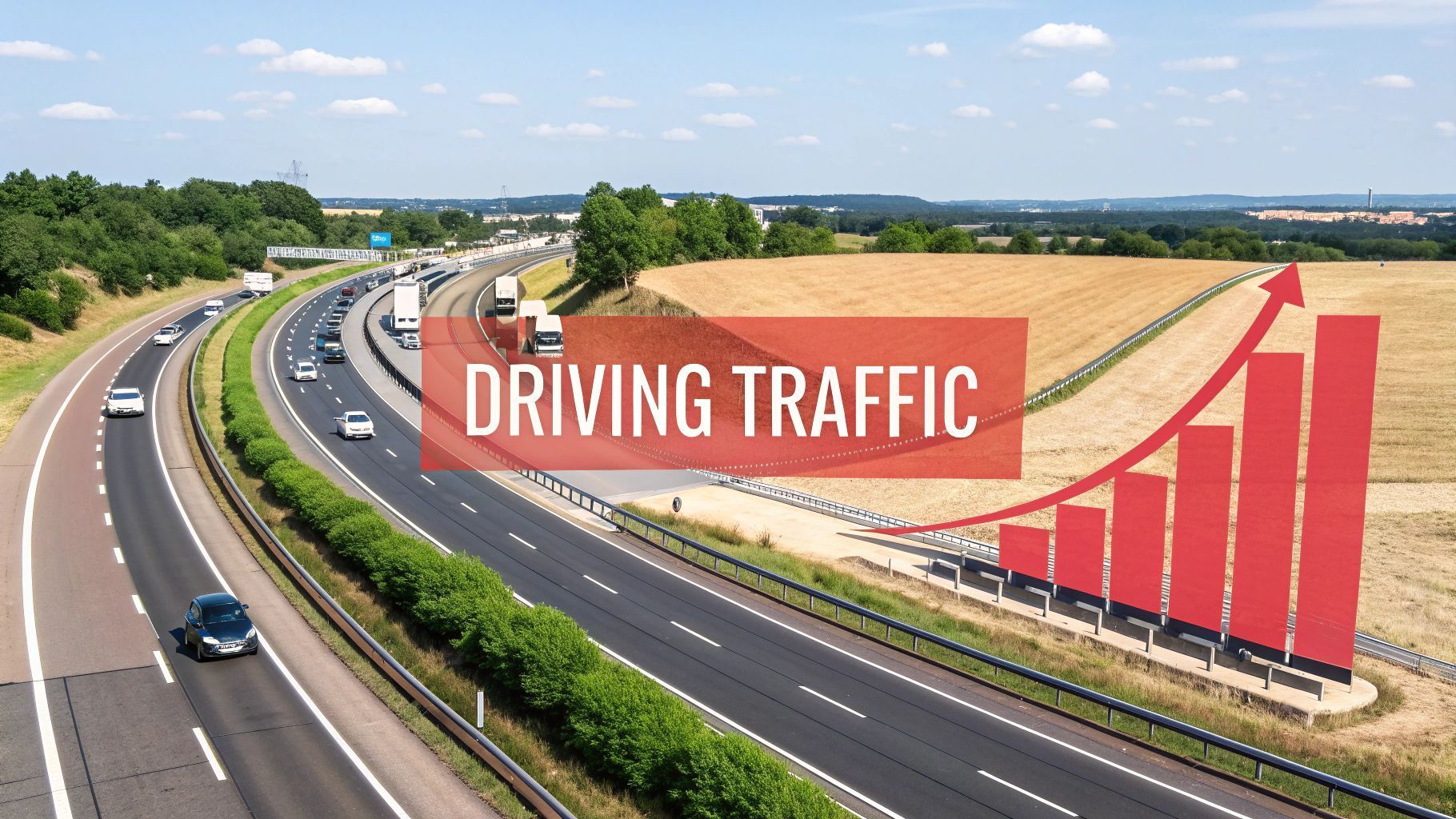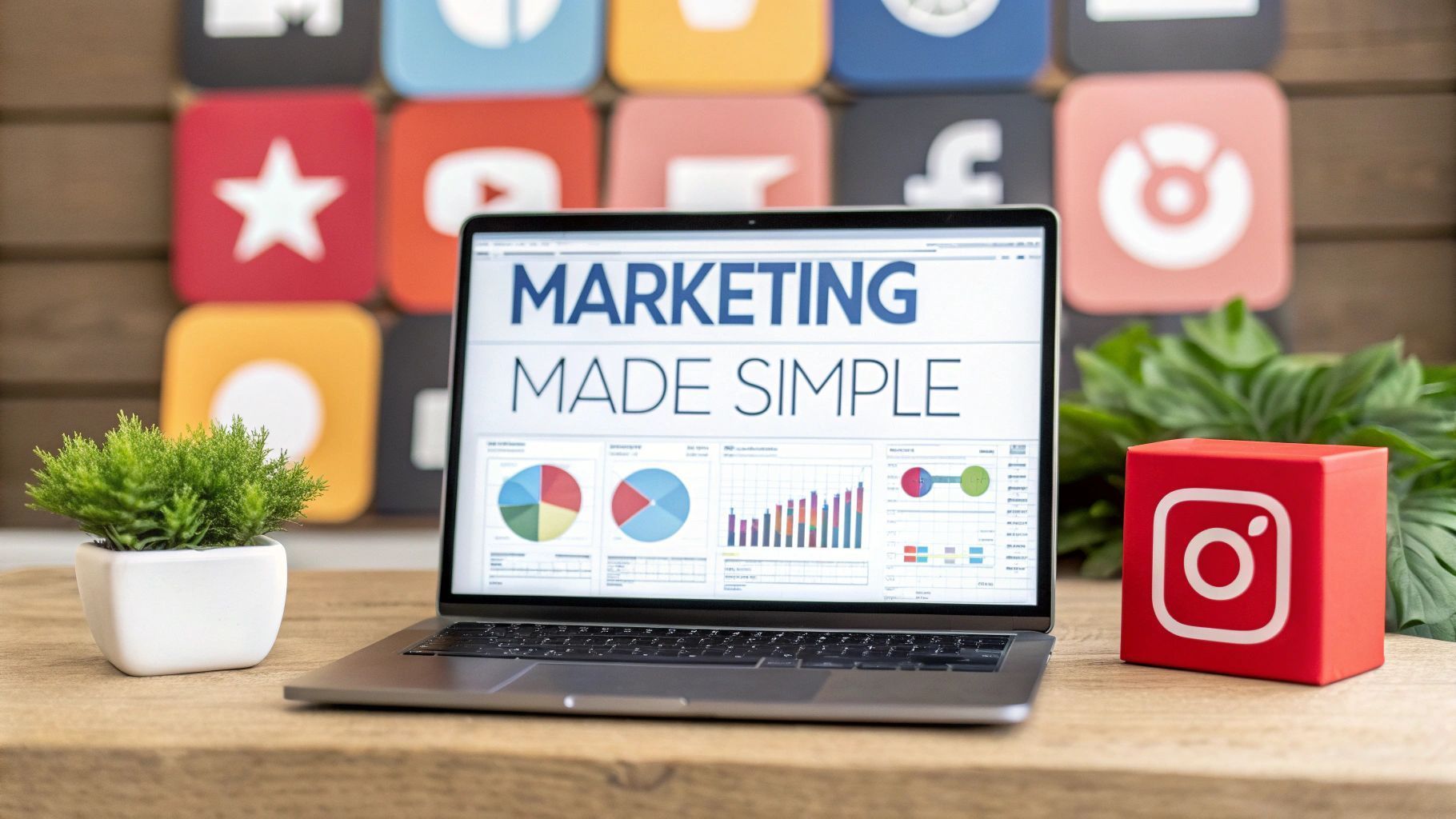Master Social Media for Tourism in the UK | Boost Visits
Using social media for tourism has evolved from a novelty to an absolute necessity. It’s now the main way modern travellers discover, plan and share their journeys. Think of it as the digital storefront for destinations, hotels and experiences, directly shaping booking decisions with compelling visuals and authentic stories.
Why Social Media Is Essential for UK Tourism
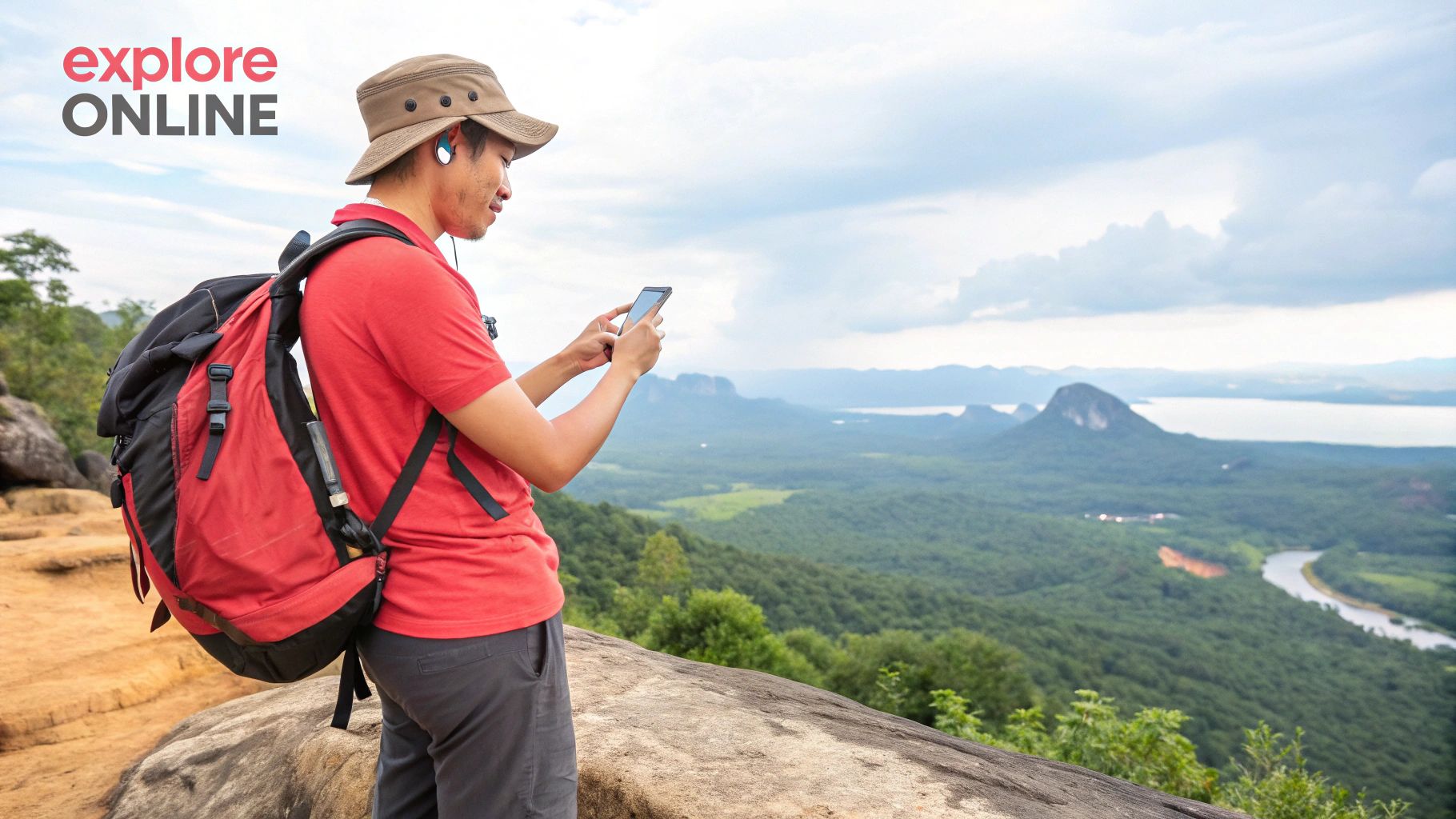
The days of relying solely on glossy brochures and travel agent tips are well and truly over. Today, a traveller’s journey almost always starts with a simple scroll through an Instagram feed or a search on TikTok. This shift has completely changed how tourism businesses in the UK must operate.
A strong social media presence isn’t a 'nice to have' any more; it’s a critical tool for survival and growth. It’s the engine for discovery that allows a boutique hotel in the Cotswolds or a scenic boat tour in Scotland to reach a global audience in an instant.
The Economic Impact
The influence of social media runs deep into the UK’s economy. The tourism industry is a massive contributor, with related activities making up 10% of the British GDP and visitor numbers hitting a record 41.2 million . Social platforms are vital for keeping this momentum going.
In essence, your social media channels are your most dynamic and interactive marketing assets. They provide a direct line to potential guests, offering a platform to showcase your unique story, build a community and drive direct bookings.
Building Relationships and Trust
Beyond just showcasing pretty pictures, social media for tourism is about building relationships. It’s your chance to engage directly with your audience, answer their questions in real-time and get valuable feedback. That consistent interaction builds a genuine sense of community and trust.
This engagement is also the bedrock of loyalty. When followers feel connected to your brand, they’re far more likely to book with you and become vocal advocates for your business. It transforms passive followers into an enthusiastic community who feel a real connection to your brand long before they even arrive.
You can dive deeper into this in our guide on the role of social media in building brand loyalty to learn more about creating lasting customer relationships.
Building a Winning Tourism Social Media Strategy
Jumping onto social media without a clear plan is like setting off on a road trip with no map. Before you even think about posting that first stunning photo, you need a solid strategy. This is what turns aimless scrolling into actual business results. A winning approach is always built on three things: clear goals, a deep understanding of your audience and a sharp eye on the competition.
Your strategy begins by defining what success actually looks like for your business. Vague ambitions like "get more followers" won't cut it. Instead, you need to focus on specific, measurable objectives that directly impact your bottom line. This gives you a clear benchmark to measure performance against and keeps your entire team pulling in the same direction.
Define Your Goals and Know Your Audience
Setting concrete goals is the most critical first step. Seriously, think about what you truly want to achieve. Are you aiming to increase direct website bookings through social media by 20% this quarter? Or maybe you want to boost engagement on your Instagram Stories to build a more active, loyal community?
Here are a few examples of strong, measurable goals:
- Increase website referral traffic from social media by 15% in the next six months.
- Generate 50 qualified leads for group bookings via Facebook lead ads each month.
- Grow your email list by 300 new subscribers from a targeted Instagram campaign.
Once your goals are crystal clear, you need to know exactly who you're talking to. Go beyond generic demographics and start creating detailed 'travel personas' that feel like real people. What are their motivations? What’s their travel style? What do they actually type into a search bar? Are they adventurous solo travellers hunting for unique experiences or are they families just looking for a relaxing, hassle-free getaway?
Creating these personas is a game-changer. It allows you to craft content that resonates on a personal level. You stop shouting into the void and start having meaningful conversations with the people most likely to book with you.
Analyse Your Competitors and Find Your Niche
Next up, it’s time for a bit of digital reconnaissance. Take a close look at what your competitors are doing online. Analyse their social media presence to see what's working well for them and just as importantly where the gaps are. The goal isn't to copy their approach; it's to find opportunities to differentiate your brand and offer something unique. When you’re developing your overall social media plan, understanding the strategies for creating viral content can give you a massive head start.
Ask yourself these key questions during your analysis:
- Which platforms are they most active on?
- What kind of posts get the most likes, comments and shares?
- What’s their brand voice and tone like? Casual? Luxurious? Witty?
- How do they interact with their followers?
This analysis will help you find your unique voice in a very crowded space. By understanding the landscape, you can carve out a niche that makes your destination or business the obvious choice. Building a comprehensive plan from the get-go is fundamental and our expert tourism marketing services can help you craft a bespoke strategy that delivers tangible results.
Choosing the Right Social Platforms for Your Brand
Not all social platforms are created equal, especially in the visually-rich world of travel. One of the most common mistakes I see is businesses spreading themselves too thin, trying to be everywhere at once. This approach just drains your resources and delivers flat results.
The real key to effective social media for tourism is to be selective. Focus your energy where your ideal guests are already spending their time. It’s a shift from a ‘be everywhere’ mindset to a ‘be where it matters’ one. Each platform has its own unique audience and content style and understanding these nuances is the first step to building a presence that actually drives bookings.
Instagram for Visual Storytelling
For any tourism business, Instagram is a natural powerhouse. Its entire format is built around visuals, making it perfect for showcasing breathtaking landscapes, luxurious hotel interiors and unforgettable experiences. This is where potential travellers go for pure inspiration, building wish lists of future destinations based on the stunning content they scroll through.
Think of it as your digital brochure but one that's alive and interactive. Use high-quality photos, engaging Reels and immersive Stories to transport your audience directly to your location. For example, a boutique hotel in Cornwall could post a Reel showing a time-lapse of a sunset from its sea-view rooms. It instantly creates that feeling of wanderlust we’re all chasing.
Facebook for Community and Conversion
While Instagram is brilliant for inspiration, Facebook remains a vital tool for building a community and driving actual conversions. It’s where you can foster deeper connections with past and future guests, sharing more detailed information, local tips and exclusive offers.
Its advertising tools are also incredibly precise, allowing you to target specific demographics who are already interested in your kind of travel experience. A historic city tour company, for instance, could create a Facebook event for a special themed walk and then run targeted ads to people who have shown an interest in UK history and live within a 50-mile radius. It’s a fantastic platform for turning casual interest into direct action.
TikTok for Authentic Connection
To connect with younger travellers, you simply cannot ignore TikTok. This platform thrives on authentic, unpolished and entertaining short-form video. It’s less about perfectly curated shots and more about capturing the genuine vibe and fun of an experience.
A quirky B&B in the Peak District could create a "day in the life" video or share some behind-the-scenes content that feels real and relatable. The results can be staggering.
The real power of TikTok lies in its ability to generate massive organic reach through trends and user-generated content. A single viral video can put a little-known destination on the map for a whole new generation of travellers.
Choosing where to focus your efforts can feel overwhelming. To make it easier, I've put together a simple guide to help UK tourism businesses decide which platforms align best with their goals.
Platform Selection Guide for UK Tourism Businesses
| Platform | Primary UK Audience | Best For | Content Type Example |
|---|---|---|---|
| 18-34, Female-skewed | Inspiration, brand building, visual storytelling | A Reel showcasing the "Top 5 hidden gems" near your location. | |
| 35-65+, Balanced gender | Community building, direct bookings, events | Posting an exclusive "early bird" discount for returning guests. | |
| TikTok | 16-24, Skewed slightly female | Reaching younger audiences, authentic content, viral potential | A quick, humorous video of a "day in the life" of your hotel staff. |
| X (Twitter) | 25-49, Male-skewed | Real-time updates, customer service, industry news | Live-tweeting a local festival or sharing travel disruption updates. |
| 25-44, Heavily female-skewed | Travel planning, inspiration boards, driving web traffic | Creating a board titled "Your Ultimate Lake District Itinerary" with links. |
This table is a starting point, of course. The best strategy often involves a mix of platforms, each playing a distinct role. The key is to understand who you're talking to and what you want them to do.
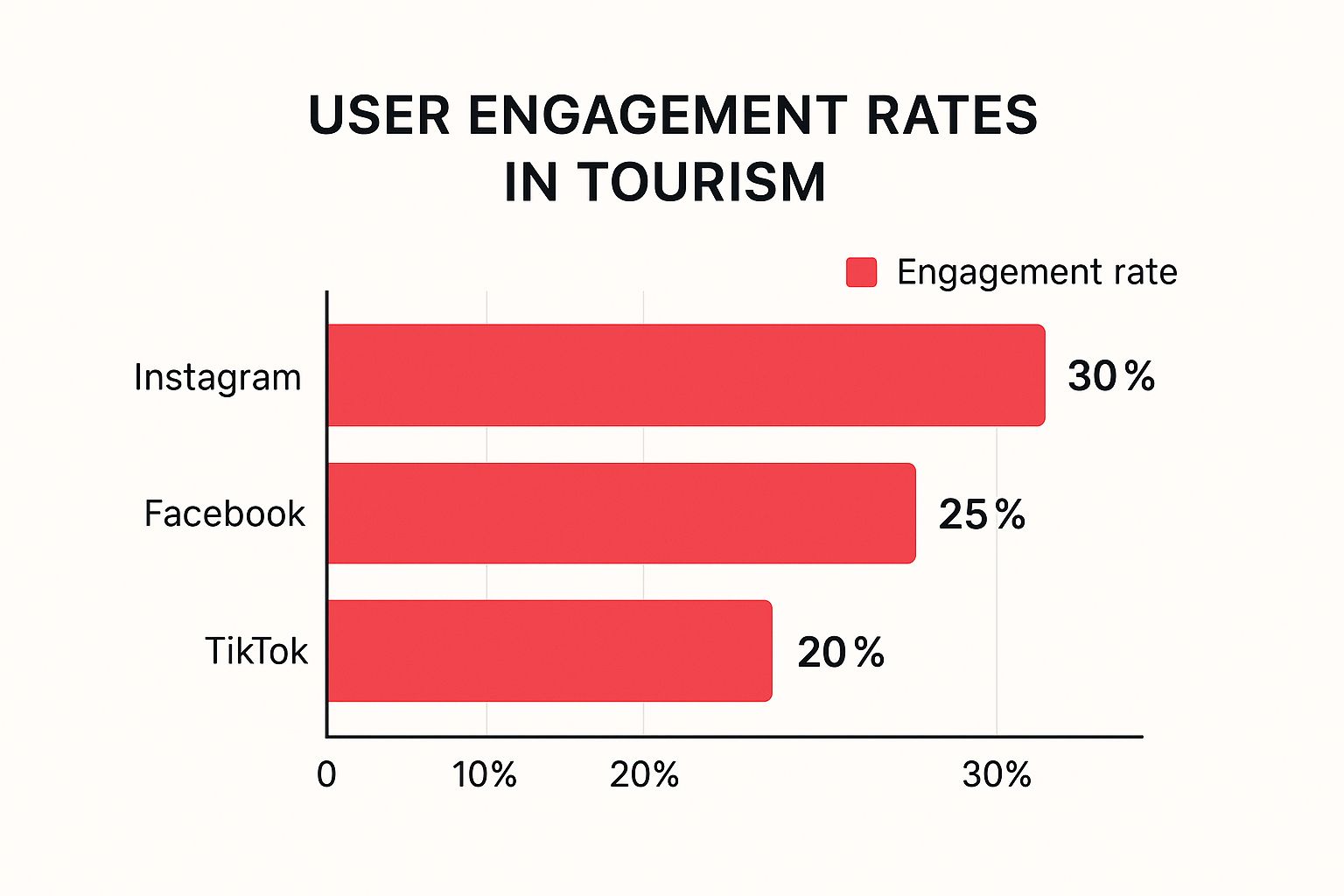
The social media landscape is deeply integrated into UK life, with a massive 79% of the population actively using these platforms. Younger adults in the 18-24 age group are spending over six hours online every single day, making platforms like TikTok and Instagram incredibly influential in their travel decisions.
If you want to dive deeper into the numbers, you can read the full research about UK social media statistics on sproutsocial.com.
Creating Content That Inspires Real Wanderlust
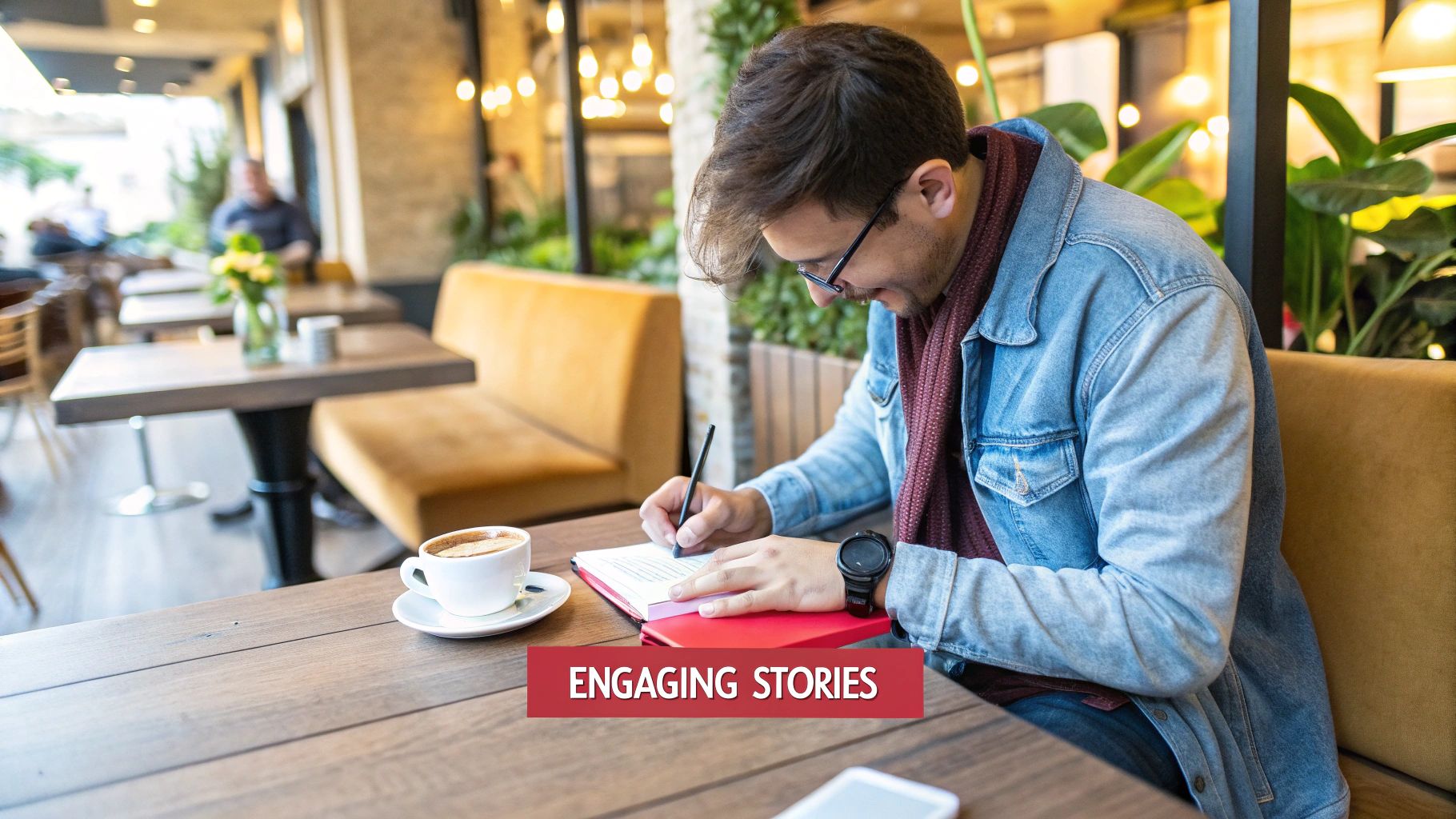
With a solid plan in place, it’s time for the fun part: creating content that actually stops the scroll and makes people feel something. Forget generic scenic shots. To build a social media presence that people genuinely want to follow, you need to think in terms of ‘content pillars’.
These are the core themes you’ll return to again and again. They give your feed structure and save you from the pressure of wondering what to post each day, ensuring you’re always adding value.
Building Your Content Pillars
Think of your pillars as the main story angles that define your brand. A few strong pillars are all it takes to build a varied, interesting feed that prevents you from posting the same kind of photo over and over again.
Here are a few ideas that work wonders for tourism businesses:
- Local Secrets: Go beyond the obvious tourist trail. Show off that hidden-gem café with the incredible scones or a secluded viewpoint only the locals know about. This instantly positions you as a trusted, in-the-know guide.
- Meet the Team: Introduce the people who make the magic happen. A short video with your head chef or a fun Q&A with your tour guides adds a human element that builds a real connection. People buy from people, after all.
- Guest Highlights: Your guests are your most powerful advocates. Sharing their photos and stories (with permission, of course) acts as powerful social proof and lets others imagine themselves right there.
By rotating through these pillars, you start to weave a rich, multi-faceted story about your brand and your corner of the world. This is how your social media for tourism starts to feel authentic and alive.
The goal is to shift from being just another service provider to becoming a storyteller. Authentic stories create an emotional connection that turns passive followers into excited visitors.
Harnessing the Power of Video and UGC
Static images are great but video is where you bring an experience to life. And you don’t need a Hollywood budget to make it happen.
A simple, well-shot smartphone video walking through your hotel or capturing the buzz of a local market can be incredibly effective. Think about time-lapses of a sunset from your balcony or quick, candid interviews with happy guests. For a real showstopper, you can explore how drone footage can take your marketing to the next level and showcase your location from a breathtaking aerial view.
Just as important is user-generated content (UGC). Get your visitors involved! Create a unique, memorable hashtag and promote it on-site. When you reshare their content, it not only gives you a stream of authentic posts but also acts as a powerful, trusted endorsement from a real person.
Tapping into Influential Platforms
Some platforms are just built for sparking wanderlust. TikTok, in particular, has become a massive player in the UK tourism sector, with 24.8 million users aged 18 and over.
The intent to buy on the platform is incredibly high, with 52% of weekly users keen to shop directly through the app. This opens up a huge opportunity for authentic, engaging content that can lead directly to bookings. You can dig into more UK social media trends at talkwalker.com.
Engaging Your Community and Managing Your Presence
Creating fantastic content is a great start but it’s only half the story. The real magic of social media for tourism happens when you start building a genuine community. Too many brands treat these platforms like a megaphone but they were built for conversation. Engaging with your audience is what turns passive followers into loyal advocates and eventually paying guests.
This all comes down to being present and responsive. When someone takes the time to comment on your photo or send you a message, they’re reaching out for a connection. A prompt, personal reply shows you’re listening and that you value their interest. It’s a small gesture but it builds a foundation of trust that makes a massive difference in how people see your brand.
Fostering an Active Online Community
Don’t just wait for people to talk to you—give them a reason to. The best way to build a vibrant community is to create content that actively invites people to join in. Instead of just showing off your beautiful destination, ask questions and pull your followers into the conversation.
Interactive content is your secret weapon here. A few simple ideas that work time and time again:
- Run a poll on Instagram Stories asking followers to vote on their favourite local walking trail.
- Host a Q&A session with your head chef to talk about the local cuisine.
- Launch a photo contest encouraging guests to share their best holiday snaps using a unique hashtag.
These aren’t just tricks to boost your engagement stats. They make your audience feel seen and heard, transforming your social media profile from a simple gallery into a lively hub for people who love what you do. You’re creating a shared space where people feel like they’re part of your story.
Responding to All Feedback
Managing your online presence also means being ready for feedback of all kinds. Glowing five-star reviews are brilliant and you should always take a moment to thank people for them. But it’s how you handle the critical comments that truly shows the character of your brand.
A negative review isn’t a disaster; it’s an opportunity. The right move is to acknowledge the issue publicly, express genuine regret that their experience fell short and then offer to move the conversation to a private channel like a DM or email. This approach shows everyone watching that you take feedback seriously and are committed to making things right. That kind of transparency can build more trust than a dozen positive reviews.
A prompt, professional and empathetic response to a negative comment can often turn a dissatisfied customer into a loyal advocate. It demonstrates that you care about the guest experience, even after they’ve left.
Staying Consistent Without Burning Out
Keeping up an active, engaging presence demands consistency but it shouldn’t take over your entire day. This is where scheduling tools become your best friend. Platforms like Buffer , Later or Hootsuite let you plan and schedule your posts in advance, freeing you up to focus on the real-time engagement that matters.
Block out a couple of specific times each day just to check for comments, messages and any mentions of your brand. Monitoring mentions is crucial—it helps you jump into conversations about your business that you might have otherwise missed completely. A little bit of organisation is all it takes to maintain a strong, consistent presence without feeling overwhelmed.
Measuring What Matters and Optimising Performance

A successful strategy for social media for tourism is built on data, not guesswork. Pouring effort into creating beautiful content is pointless if you don't know whether it’s actually working. This is where you turn your social media from a creative outlet into a powerful, business-driving machine.
It's easy to get lost in a sea of numbers but you only need to focus on the metrics that line up with the goals you set earlier. These are your Key Performance Indicators or KPIs. They cut through the noise and tell you what’s truly making an impact.
Identifying Your Core KPIs
Instead of tracking every metric under the sun, concentrate on the data that directly reflects your business objectives. This clarity is what helps you make smarter decisions about where to invest your time and budget.
For most tourism businesses, the KPIs that matter most fall into three main camps:
- Awareness Metrics: This is all about how many people are seeing your content. Keep an eye on Reach (the unique number of accounts that saw your post) and Impressions (the total number of times your post was seen). A healthy reach means your content is spreading its wings.
- Engagement Metrics: This shows you how your audience is actually interacting with what you post. The essentials here are Likes , Comments , Shares and Saves . A high engagement rate is a clear sign your content is hitting the mark with your followers.
- Conversion Metrics: This is the big one, linking your social media activity directly to your bottom line. Track your Website Referral Traffic from social channels and most importantly Direct Booking Conversions .
Using Platform Analytics to Your Advantage
You don't need fancy, expensive software to get started. Platforms like Instagram and Facebook offer powerful, free analytics tools right inside their apps. Instagram Insights, for example, can show you which posts reached the most people or which Stories got the most replies.
Facebook's Meta Business Suite digs even deeper, letting you see the demographics of your engaged audience and track how people are interacting with your page. Make a habit of checking these dashboards—maybe once a week—and you'll quickly start to spot patterns.
Look for the outliers. If one particular Reel gets three times the usual number of shares, analyse why. Was it the format? The topic? The time of day you posted? These insights are gold because they give you a clear roadmap for what to create next.
Turning Data into Actionable Insights
The real skill isn't just collecting numbers; it's turning them into smart business decisions. Data on its own is useless. It’s the insights you pull from it that drive genuine improvement.
For instance, if you notice your website traffic from social is high but your booking conversions are low, the problem might not be your social content. It could be the user experience on your booking page. If video consistently gets higher engagement, that's a clear signal to invest more time creating Reels and Stories.
This continuous cycle of measuring, analysing and refining is what separates the successful brands from the rest. To really sharpen your campaign's effectiveness, you can explore advanced techniques like retargeting in marketing to reconnect with people who have already shown interest in your destination. By truly understanding what resonates, you can constantly tweak your strategy for better and better results.
Your Tourism Social Media Questions Answered
When it comes to the nitty-gritty of social media for tourism, there are always a few practical questions that pop up. Here are some straightforward answers to the queries we hear most often from UK tourism pros.
How Much Should a Small UK Tourism Business Spend on Social Media Ads?
Honestly, there's no single magic number. A sensible place to start is earmarking around 5-10% of your total marketing budget for social ads.
Don't feel you have to go all-in from day one. Kick things off with a small daily budget, maybe £5-£10 on a platform like Facebook, just to test the waters. See which audiences respond and what kind of creative gets clicks. Focus on one clear goal, like driving bookings for a seasonal offer, and once you see something working, you can confidently put more budget behind it.
The key isn't to spend a fortune right away. It's about starting small, testing everything and letting the data tell you where to put your money. The best ad strategies are built on learning and adapting, not just a big initial spend.
What's the Single Biggest Mistake to Avoid?
Without a doubt, it's inconsistency. Going completely quiet for weeks and then bombarding your audience with several posts in one day is a surefire way to kill your engagement. The platform algorithms really don't like it.
A simple content calendar and a scheduling tool are your best friends here. They help you maintain a steady, reliable presence. Remember, consistency builds trust and keeps your brand front-of-mind, so when people are ready to book a trip, you're the first place they think of.
How Can I Get More People to Share Photos of My Business?
You have to ask for it and make it fun! The first step is creating a unique and memorable hashtag. Promote it everywhere: on-site at your location, in your email signature and across all your social media profiles.
Why not run a simple monthly contest for the best guest photo? Even small prizes can generate a huge response. Most importantly, always engage with and reshare the content people post (with their permission, of course). It shows you genuinely appreciate them and encourages others to join in. Make it easy and rewarding for your visitors to become your best marketers.
Ready to turn your online presence into bookings and real results? The team at Superhub lives and breathes digital marketing for the tourism sector. Visit us at Superhub to see how we can help your brand grow.

